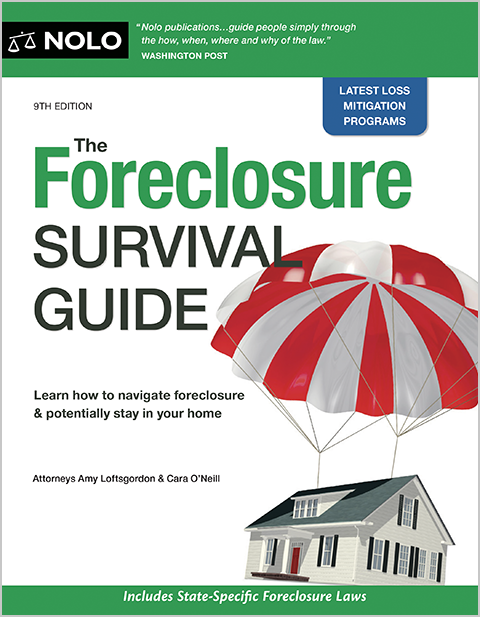What are the foreclosure laws in South Dakota? Find out here.
Before the foreclosure crisis, federal and state laws regulating mortgage servicers and foreclosure procedures were relatively limited and tended to favor foreclosing lenders. However, many federal and state laws now give protections to borrowers. Servicers generally must provide borrowers with loss mitigation opportunities, account for each foreclosure step, and carefully comply with foreclosure laws.
Also, most people who take out a loan to buy a residential property in South Dakota sign a promissory note and a mortgage containing a power of sale clause. These documents give homeowners some contractual rights in addition to federal and state legal protections.
So, don't get caught off guard if you're a homeowner behind in mortgage payments. Learn about South Dakota foreclosure laws and how the foreclosure process in South Dakota works, from missing your first payment to a foreclosure sale.
- What Are My Rights During Foreclosure in South Dakota?
- What Is Preforeclosure?
- When Can a Foreclosure Start in South Dakota?
- How the Foreclosure Process Works in South Dakota: Key Steps Explained
- What Are the Options Available for Borrowers During Foreclosure in South Dakota?
- Foreclosure Protections and Military Servicemembers
- Are Deficiency Judgments Allowed in South Dakota?
- What Are the Potential Consequences of Foreclosure?
- Get More Foreclosure Information
What Are My Rights During Foreclosure in South Dakota?
In a South Dakota foreclosure, you'll most likely get the right to:
- receive a preforeclosure breach letter
- apply for loss mitigation
- receive notice of the foreclosure
- receive special protections if you're in the military
- pay off the loan to prevent a sale
- file for bankruptcy
- redeem the home after the sale, and
- get any excess money after a foreclosure sale.
Once you understand the South Dakota foreclosure process and your rights, you can make the most of your situation and, hopefully, work out a way to save your home or at least get through the process with as little anxiety as possible.
What Is Preforeclosure?
The period after you fall behind in payments, but before a foreclosure officially starts, is generally called the "preforeclosure" stage. (Sometimes, people refer to the period before a foreclosure sale happens as "preforeclosure," too.)
During the preforeclosure period, the servicer can charge you various fees. Also, in most cases, federal law requires the servicer to let you know how to avoid foreclosure, and most mortgage contracts require the servicer to send you a breach letter.
When Can a Foreclosure Start in South Dakota?
Under federal law, the servicer usually can't officially begin a foreclosure until you're more than 120 days past due on payments, subject to a couple of exceptions. (12 C.F.R. § 1024.41 (2025).) This 120-day period provides most homeowners with ample opportunity to submit a loss mitigation application to the servicer.
How the Foreclosure Process Works in South Dakota: Key Steps Explained
If you default on your mortgage payments in South Dakota, the lender may foreclose using a judicial or nonjudicial method.
How Judicial Foreclosures Work
A judicial foreclosure begins when the lender files a lawsuit asking a court for an order allowing a foreclosure sale. If you don't respond with a written answer, the lender will automatically win the case.
But if you choose to defend the foreclosure lawsuit, the court will review the evidence and determine the winner. If the lender wins, the judge will enter a judgment and order your home sold.
What Are the Steps Involved in the Nonjudicial Foreclosure Process in South Dakota?
If the lender chooses a nonjudicial foreclosure, it must complete the out-of-court procedures described in the state statutes. After completing the required steps, the lender can sell the home at a foreclosure sale. Lenders in South Dakota sometimes opt to use the nonjudicial process because it's quicker and cheaper than litigating the matter in court.
Notice of sale. The nonjudicial process in South Dakota is pretty straightforward: The lender serves the borrower a notice of sale at least 21 days before the sale date and publishes the notice in a newspaper once a week for four weeks. (S.D. Codified Laws § 21-48-6.1, § 21-48-6 (2025).) Then the lender can sell the property at a foreclosure sale.
Converting a Nonjudicial Foreclosure into a Judicial Foreclosure. However, even if the lender starts a nonjudicial foreclosure, you can force it to foreclose judicially (in court) by applying in the appropriate court. (S.D. Codified Laws § 21-48-9 (2025).) Converting a nonjudicial foreclosure to a judicial one might be a good idea, especially if you have a strong defense to the foreclosure. If you want to convert a nonjudicial foreclosure into a judicial one, consult with a South Dakota attorney to make sure you follow the proper procedures.
How Do South Dakota Foreclosure Sales Work?
At the sale, the lender usually makes a credit bid. The lender can bid up to the total amount owed, including fees and costs, or it may bid less. In some states, including South Dakota, when the lender is the high bidder at the sale but bids less than the total debt, it can get a deficiency judgment against the borrower.
If the lender is the highest bidder, the property becomes "Real Estate Owned" (REO). But if a bidder, say a third party, is the highest bidder and offers more than you owe, and the sale results in excess proceeds (that is, money over and above what's needed to pay off all the liens on your property), you're entitled to that surplus money.
What Are the Options Available for Borrowers During Foreclosure in South Dakota?
A few potential ways to stop a foreclosure and keep your home include reinstating the loan, redeeming the property, or filing for bankruptcy. Working out a loss mitigation option, like a loan modification, will also stop a foreclosure.
Or you might be able to work out a short sale or deed in lieu of foreclosure and avoid foreclosure. But you'll have to give up your home with a short sale or deed in lieu of foreclosure transaction.
Reinstating the Loan
South Dakota law doesn't provide the borrower with the right to reinstate the loan in a nonjudicial foreclosure. The terms of the mortgage contract, however, might give you this right. To find out if you get the right to complete a reinstatement, check your mortgage contract. Or the lender might agree to let you complete a reinstatement.
If the foreclosure is judicial, state law does provide the right to reinstate. If you pay the reinstatement amount before the court enters a judgment in a judicial foreclosure, the court will dismiss the foreclosure action. But if you reinstate after judgment, but before the sale, the court will stay (postpone) the foreclosure action. If you default again, the foreclosure can continue. (S.D. Codified Laws § 21-47-8, § 21-47-10 (2025).)
What Is the Redemption Period for Foreclosure in South Dakota?
One way to stop a foreclosure is by "redeeming" the property. To redeem, you have to pay off the full amount of the loan before the foreclosure sale.
Some states also provide foreclosed borrowers with a redemption period after the foreclosure sale, during which they can buy back the home. Generally, foreclosed homeowners in South Dakota get one year to redeem the property after a foreclosure sale. (S.D. Codified Laws § 21-52-11 (2025).) But if the mortgage is a short-term redemption mortgage, the redemption period is 180 days after the person or entity who bought the property at the foreclosure sale records a certificate of sale in the land records. (S.D. Codified Laws § 21-49-30, § 21-52-11 (2025).) To find out if you have a short-term redemption mortgage, check your loan paperwork or talk to a lawyer.
Also, if the borrower abandons the property, the new owner can ask the court to reduce the redemption period to 60 days. (S.D. Codified Laws § 21-49-13(8), § 21-49-38 (2025).)
Filing for Bankruptcy
If you're facing a foreclosure, filing for bankruptcy might help. In fact, if a foreclosure sale is scheduled to occur in the next day or so, the best way to stop the sale immediately is by filing for bankruptcy.
Once you file for bankruptcy, something called an "automatic stay" goes into effect. The stay functions as an injunction, which prohibits the lender from foreclosing on your home or otherwise trying to collect its debt, at least temporarily.
In many cases, filing for Chapter 7 bankruptcy can delay the foreclosure by a matter of months. But to save your home, you'll have to be current on payments and be able to protect your equity in the property. If you want to save your home and you're behind in payments, filing for Chapter 13 bankruptcy might be the answer. To find out about the options available to you, speak with a local bankruptcy attorney.
Foreclosure Protections and Military Servicemembers
The federal Servicemembers Civil Relief Act (SCRA) provides legal protections to military personnel at risk off foreclosure.
South Dakota law extends legal protections under the federal SCRA to members of the National Guard ordered to active duty service by the Governor or the President of the United States. (S.D. Codified Laws § 33A-2-9 (2025).)
Are Deficiency Judgments Allowed in South Dakota?
In a foreclosure, the borrower's total mortgage debt sometimes exceeds the foreclosure sale price. The difference between the total debt and the sale price is called a "deficiency." For example, say the total debt owed is $400,000, but the home sells for $350,000 at the foreclosure sale. The deficiency is $50,000.
In some states, the lender can seek a personal judgment against the debtor to recover the deficiency. Generally, once the lender gets a deficiency judgment, the lender may collect this amount (in our example, $50,000) from the borrower.
Deficiency judgments are allowed in South Dakota, subject to some limitations.
South Dakota Deficiency Judgment Laws
While the lender can get a deficiency judgment after a nonjudicial foreclosure, if the lender buys the home at the foreclosure sale, the amount of the deficiency is limited to the difference between the borrower's total debt and the home's fair market value. (S.D. Codified Laws § 21-48-14 (2025).)
Deficiency judgments can also happen in judicial foreclosures. The court will take the property's value into account and look at other factors when deciding whether a deficiency exists. (S.D. Codified Laws § 21-47-16, § 21-47-17 (2025).)
What Are the Potential Consequences of Foreclosure?
A foreclosure could result in serious consequences, like lower credit scores, a deficiency judgment (as discussed above), or tax consequences.
Get More Foreclosure Information
For more information on federal mortgage servicing laws, as well as foreclosure relief options, go to the Consumer Financial Protection Bureau (CFPB) website. You can also learn more by reading Nolo's articles:
- Get tips on what to do—and what not to do—if you're facing a foreclosure.
- Learn about last-minute strategies to stop foreclosure.
- Find out if foreclosures are on the rise.
If you have questions about South Dakota's foreclosure process or want to learn about potential defenses to a foreclosure and possibly fight the foreclosure in court, consider talking to a foreclosure attorney. Talking to a HUD-approved housing counselor about different loss mitigation options is also a good idea.
- What Are My Rights During Foreclosure in South Dakota?
- What Is Preforeclosure?
- When Can a Foreclosure Start in South Dakota?
- How the Foreclosure Process Works in South Dakota: Key Steps Explained
- What Are the Options Available for Borrowers During Foreclosure in South Dakota?
- Foreclosure Protections and Military Servicemembers
- Are Deficiency Judgments Allowed in South Dakota?
- What Are the Potential Consequences of Foreclosure?
- Get More Foreclosure Information

